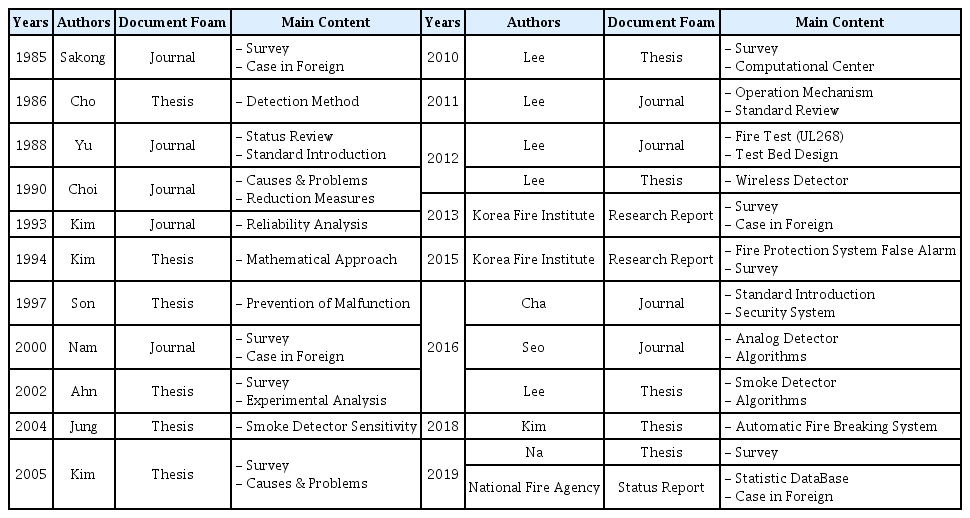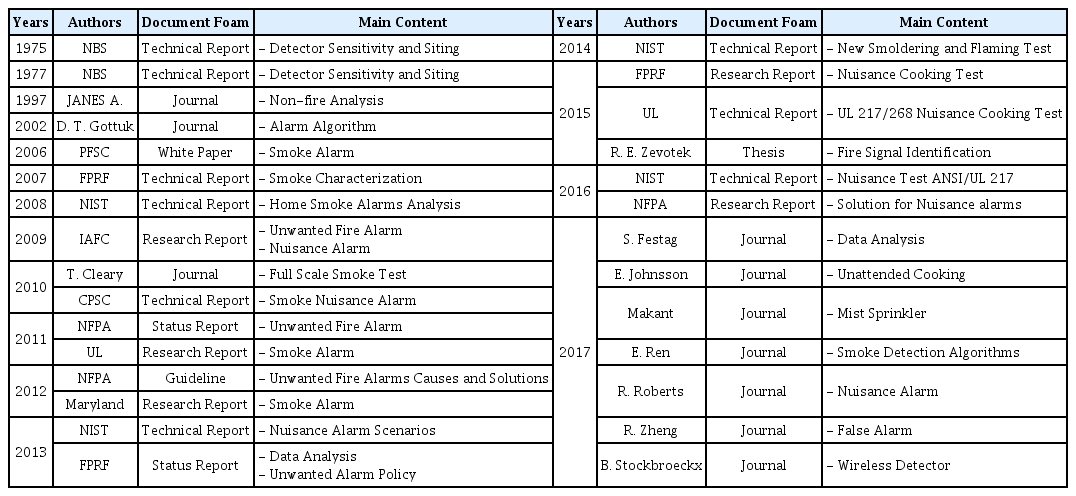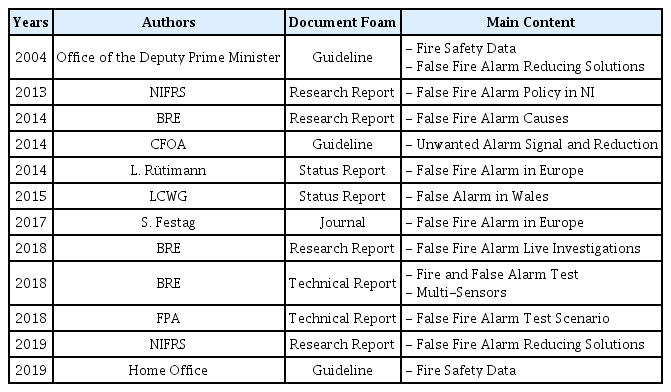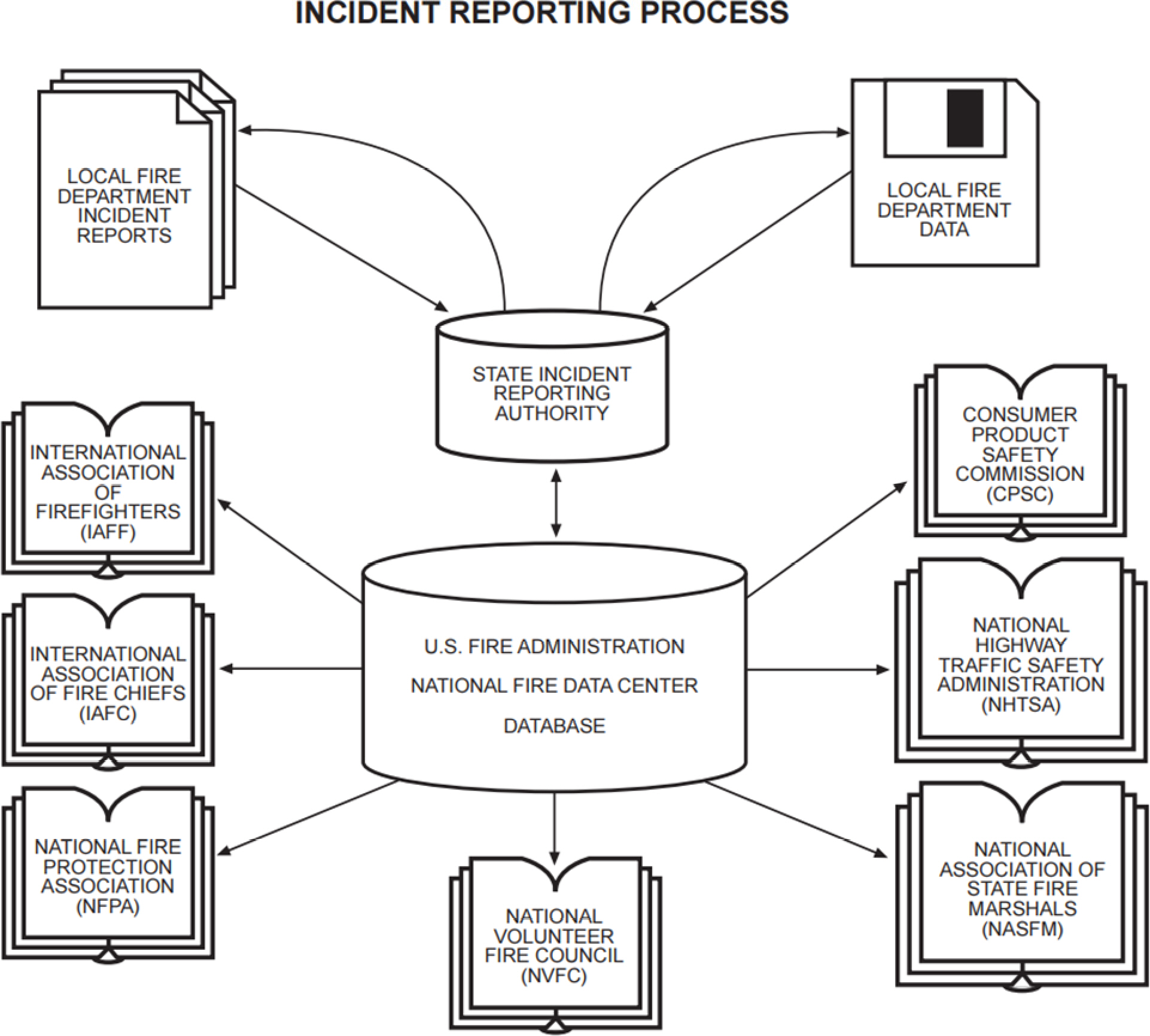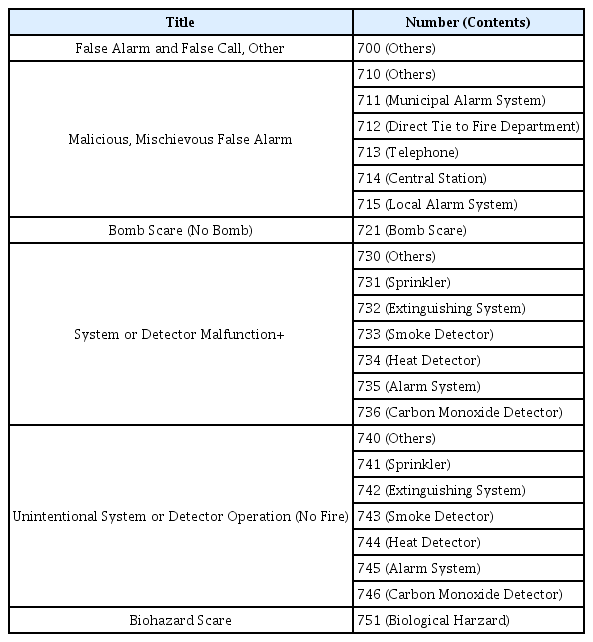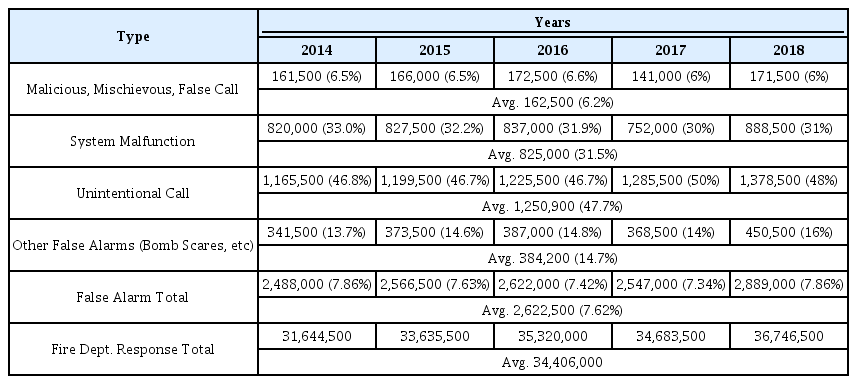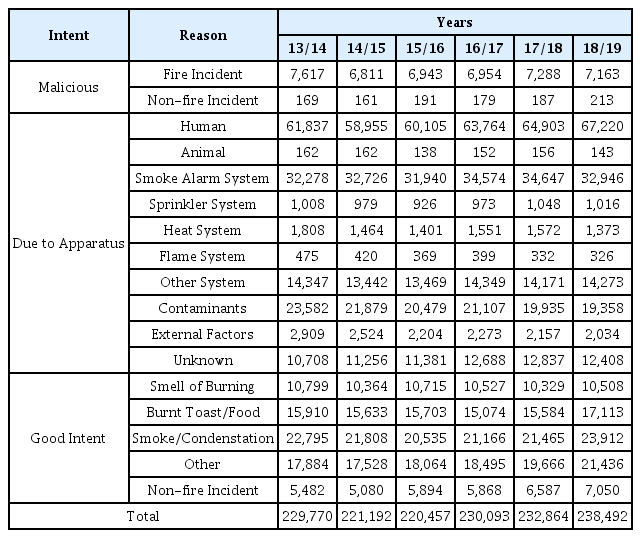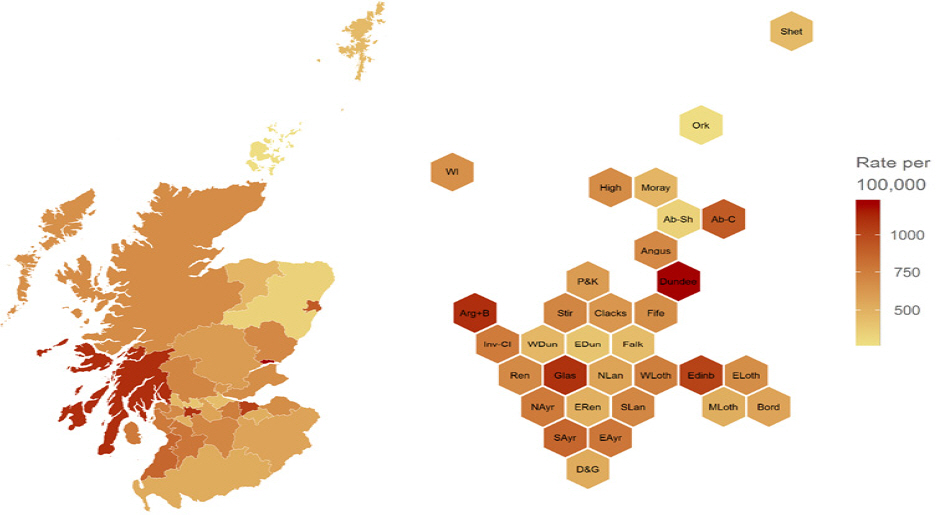국내 ⋅ 외 비화재보의 통계 및 관리체계에 관한 연구
Statistics and Management Systems of Unwanted Domestic and Foreign Fire Alarms
Article information
Abstract
요 약
화재 및 재난에서 신속 ⋅ 정확한 경보는 피해규모의 최소화와 인명 피난의 성공과 직결된다. 그러나 자동화재탐지설비의 비화재보로 인해 119서비스의 오인출동의 수가 증가하고 있다. 이는 건물의 관계인의 안전 불감증과 소방의 인력낭비를 초래한다. 따라서 본 연구에서는 국외(미국, 영국) 및 국내의 비화재보에 대한 통계 DB 및 문헌을 확인하고, 비화재보의 관리체계에 대해서 비교 ⋅ 분석하여 비화재보에 대한 통계 및 관리체계의 문제점을 확인하였다.
Trans Abstract
ABSTRACT
In the event of a fire and a disaster, prompt and accurate alarms inside and outside the building are directly related to the minimization of damage and the success of life evacuation. However, due to unwanted fire alarms in automated fire detection systems, the number of dispatches by misunderstanding in the 119 service is increasing. This causes the insensitivity to the safety of building managers and the waste of the fire-fighting power. Therefore, in this study, the statistical databases and literature on unwanted fire alarms in Korea and abroad (USA, UK) were identified and the management systems for unwanted fire alarms were compared and analyzed to identify problems of statistics in the management systems for unwanted fire alarms.
1. 서 론
1.1 연구 배경
국가산업의 발전으로 인해 건축물의 형태와 용도가 복잡 ⋅ 다양화 되었고, 재난 및 화재의 발생 그리고 피해가 증가하고 있다. 재난과 화재 상황에서 신속 ⋅ 정확한 경보는 피해 규모의 최소화와 인명 피난과 직결된다. 국내에서는 재난 및 화재 경보를 위한 설비로써 대표적으로 자동화재탐지설비(이하, 자탐설비라고 한다.)를 설치 및 사용하고 있다.
자탐설비는 감지부에서 화재로 인해 발생하는 열, 연기, 불꽃 등 각종 물리 ⋅ 화학적 현상을 감지하고 화재여부를 판단하여 화재 수신기와 경종 그리고 시각경보기를 작동시켜 재실자의 신속한 피난과 초기 소화를 위해 설비와 연동되어 피해규모를 줄이는데 도움을 주는 경보설비이다.
하지만 자탐설비의 감지기에서 비화재보(非火災報) 즉, 화재와 유사한 환경이 조성되는 경우 화재가 발생하지 않았음에도 화재로 인지하여 경보를 발하는 경우가 빈번히 발생하고 있다.
소방청 자료에 따르면 2014년 이후 신고 출동은 5년간 610,903건이고, 그중 화재출동이 아닌 비화재보 등으로 인 한 오인출동 건수는 394,373건으로 전체의 64.6%이고 매년 오인출동의 건수가 증가하는 것이 확인되었다(1).
비화재보의 빈도가 증가하면 소방관계인이 평시에 경보신호에 대한 출력을 정지시키거나, 전원을 완전히 차단하는 등 불안전한 조치를 하는 경우가 발생하고 전반적인 국가 소방서비스의 시스템에 대한 신뢰성 저하와 오인출동으로 인한 소방의 인력낭비를 초래한다. 이는 재난 및 화재발생 상황에서 적절한 대응을 취하기 어렵게 되고 인명 및 재산피해의 정도가 더 커지는데 영향을 미치기 때문에 비화재보에 대한 대책마련이 필요하다.
2. 국내 ⋅ 외 비화재보 연구 문헌 검토
2.1 국내
국내의 비화재보에 대한 연구는 Table 1에 나타낸 것과 같이 1985년 Sakong의 연구부터 2019년 소방청의 비화재보 저감대책에 대한 연구까지 다양하게 진행되어 왔고 꾸준히 연구가 지속되어왔다는 것을 확인할 수 있었다(2,24).
총 23개의 문헌을 검토한 결과, 연구의 주요내용은 비화재보의 정의 및 현황 분석. 실태 및 설문조사, 국내 ⋅ 외 사례 및 기준분석, 감지기의 작동 및 측정원리 분석, 감지기의 감도향상 및 신뢰성을 위한 알고리즘제안, 비화재보 관련 실험실시 및 실험장 구축, 비화재보의 원인 및 문제점, 각 원인 별 개선방안에 관하여 연구가 지속해서 진행되고 있다(2-24).
2.2 미국
미국의 비화재보 관련 연구는 다양하게 진행되고 있으며, 국내보다 선진화된 방법으로서 비화재보에 대한 문제를 해결하고 있었다.
Table 2에는 미국의 주요 기관 및 학계에서 진행된 연구내용 등을 나타내었다. 총 29개의 문헌을 검토한 결과 연구의 주요내용으로는 비화재보의 현황 및 관련 데이터 분석, 화재 및 연기경보, 비화재보 그리고 방해경보와 관련된 원인 및 저감대책, 비화재보시험기준 마련을 위한 비화재보 시나리오 및 알고리즘에 대한 실험적 고찰 등이 였다(25-53).
2.3 영국
영국의 비화재보 관련 연구도 미국과 마찬가지로 다양한 방면에서 진행되고 있었으며, 점검 설명서, 점검 플로차트 등 체계적인 방법으로 비화재보를 관리하고 있었다.
Table 3에 영국의 주요 기관 및 학계에서 진행된 연구내용 등을 나타내었다. 총 12개의 문헌을 검토한 결과 비화재보의 현황 및 관련 데이터분석, 소방대의 출동, 비화재보 관련 정책, 비화재보의 영향 및 문제점, 화재 및 비화재보 시나리오에 따른 실험적 고찰, 복합형감지기의 비화재보 성능 실험 등이 있었다(54-65).
3. 국내 ⋅ 외 비화재보 통계 DB 관리현황
3.1 국내
국내 화재통계 데이터는 각 소방서 및 지자체에서 수집된 사고보고서 등을 바탕으로 소방청의 국가화재정보시스템에서 수집 및 구축되고 있으며, 7가지 일반현황, 6가지의 발화장소 및 지점, 행정구역 및 소방관할관서에 따라 통계를 확인 할 수 있다.
그러나 소방청에서 구축한 통계 DB를 검토한 결과 비화재보에 대한 내용은 존재하지 않았다. 다만, 자탐설비의 미작동에 대한 내용은 수집하고 있었다. 그러나 미작동은 단어 그대로 작동하지 않은 경우를 모두 포함하기 때문에 비 화재보라고 볼 수 없어 소방청에서 2018년도 3월부터 5월까지 3개월동안 비화재보에 대해 수집 ⋅ 파악하였고 이를 Table 4와 Table 5에 나타내었다(66-67).
Table 4는 요인별 비화재보 발생건수 및 비율이다. 인위적 요인이란, 조리에 의한 열 ⋅ 연기, 흡연에 의한 연기, 자동차 등의 배기가스, 공사 중 발생하는 분진, 장난 및 실수 등으로 인한 것을 의미하며 관리적 요인이란 감지기 내부 청소 및 관리 불량, 건축물의 갈라진 틈에 의한 침수, 감지기주위의 부적정한 환경 등으로 작동한 것이고, 시스템요인은 노후, 시공, 기기의 오류 등으로 인한 것을 의미한다. 요인별 비화재보 발생건수 및 비율은 인위적요인 1,302건(40.6%), 관리적요인 1,007건(31.4%), 시스템요인 897건(28%)순으로 확인되었다.
Table 5는 특정소방대상물 23개 시설에서 상위 4개 시설의 비화재보 발생건수를 나타내었다. 시설별 비화재보 발생건수는 근린생활시설 2,267건(29.7%), 공동주택 1,639(21.4%), 공장 1,222건(16.0%), 노유자시설 577건(7.5%)등 순으로 나타났다. 그러나 화재경보가 작동한 화재와 비화재보발생건수를 비교한 결과 다른 시설들에서는 비화재보발생건수가 약 200% 정도로 2배 정도 많은 것에 비해 노유자시설은 약 2,321%로 23배 이상 많다는 것이 확인되었다. 따라서 비화재보 발생건수가 가장 많다고 해서 가장 자탐설비에 대한 신뢰성이 떨어지는 시설이라고 할 수 없고 화재경보가 적절하게 이뤄진 화재건수를 고려하여 판단해야할 필요성을 확인하였다.
3.2 미국
미국의 화재 및 사고통계데이터 구축은 National fire incident recording system (NFIRS)를 통해 실시되고 있다. Figure 2와 같이 화재 및 사고통계를 종합적 수집하여 DB를 구축하고 있다. 각 지역소방서의 사고보고서 및 데이터를 이용하여 주 소방당국과 U.S 연방정부에 최종적으로 데이터가 전달된다. 확보된 데이터의 양질에 대해 연방정부의 National fire data system (NFDS)에서 평가 및 검토한 후 NFIRS 5.0 모듈을 바탕으로 데이터가 구축된다. 연간 구축된 데이터는 National fire protection associate (NFPA) 등 유관기관에 전달되어 최종 분석하여 가공되는 형태이다. NFIRS의 통계 구축 모듈은 총 12개의 모듈로서 나타내고 있으며 이중 비화재보에 대한 내용은 Basic module (NFIRS-1)의 Section C에 포함되며 코드넘버 700번류에 해당한다. Table 6은 비화재보 코드 유형에 대해서 나타내었고 Figure 3은 Basic module의 Incidet type에 대한 표시방법 샘플 및 양식을 나타내었다(68). 모듈 작성방법은 Table 6의 번호와 내용을 Figure 3의 빈칸의 해당위치에 표기하는 형식이다.
이러한 방식으로 미국화재데이터센터에서 구축된 통계데이터는 미국방화협회인 NFPA에서 활용하여 매년 Fire loss in the united states during 해당연도의 이름으로 화재관련 통계자료를 수집 및 현황보고를 하고 있다(69-73).
지난 2014년부터 2018년도까지의 자료를 확인하였을 때, 소방대의 전체신고 대응건수와 거짓경보로써 비화재보 대응건수를 확인할 수 있었고 각각의 비화재보 대응건수의 세부내역 및 비율에 관해서 확인 할 수 있었다. Table 7에 소방대의 전체응답건수 및 비화재보의 유형별 응답건수에 대해서 나타내었다. 전체적인 소방대의 응답건수는 매년 증가하는 추세이며 비화재보 대응건수도 증가하고 있다. 비화재보 신고 유형의 5년간 평균값을 비교한 결과 비고의적 전화 1,250,900건(47.7%), 시스템상 오류 825,000건(31.5%), 기타 거짓경보(폭발위협) 384,200건(14.7%), 악의적 ⋅ 장난 ⋅ 거짓말 162,500건(6.2%)로서 확인 되었고, 소방대 응답건수 대비 비화재보 건수의 비율은 7.62%로 확인되었다.
미국은 비화재보 응답건수에 대한 통계 DB를 확보하고 있고 비화재보를 4가지(악의적, 시스템의 오류, 비의도적, 기타 폭탄위협 등)의 원인별로 분류하는 것을 확인할 수 있었다.
3.3 영국
영국은 잉글랜드에서 통합적으로 통계를 관리하며 스코틀랜드, 웨일즈, 북아일랜드에서 자치국별로 비화재보에 통계 DB를 수집하고 있었다. 그리고 수집한 내용을 잉글랜드의 영국 통합통계 데이터셋에서 비화재보 통합 DB를 구축하고 있다. Table 8에 2013/14부터 2018/19까지의 원인별 비화재보에 대해 나타내었다(74-76).
영국의 통계자료를 확인한 결과 각각의 자치국마다 조사하는 방식의 기본적인 틀은 3가지(악의적, 기기의 오류, 선한의도)로 나눈다는 점이 유사하였다. 악의적이란 존재하지 않는 화재사건에 화재 및 구조 서비스가 출동하도록 만든 악의적인 신고를 한 경우를 의미하며 ‘계획적’ 및 ‘의심스러운 악의’가 포함된다. 기기의 오류란 화재 경보 및 소방기기 작동(개인이 실수로 경보 장치를 작동시킨 경우 포함)으로 신고접수가 된 경우를 의미하고, 좋은 의도란 실제로 화재가 발생하였다고 믿은 사람이 화재 및 구조 서비스에 좋은 의도로 신고한 경우를 의미한다.
자치국별 특이사항으로 스코틀랜드의 경우는 의도와 장소에 따라 나누었는데 가정집, 기타빌딩, 차량, 기타, 위치 미확인으로 5가지로 세분화 하였다. 특히 Figure 4에 나타낸 것처럼 스코틀랜드는 기기의 오류가 원인이 되는 비화재보를 장소별로 나타낸 시각적 자료가 존재한다는 것을 확인할 수 있었다. 웨일즈의 경우는 다른 자치국의 재정연도 및 기준달이 전년 7월부터 금년 6월인 것과 달리 재정연도 및 기준달이 전년 4월부터 금년 3월인 것에서 차이점을 확인할 수 있었다. 북아일랜드의 경우는 최종적으로 조사한 데이터가 2015년인 것으로 보아 매년 통계를 조사하는 것이 아닌, 필요할 경우에 비화재보에 대한 통계를 내고 있음을 확인할 수 있었다(77-79).
4. 비화재보 통계 및 관리체계의 문제점
4.1 국내 연구의 한계
미국은 일찍이 1975년에 경보설비에 대한 연구가 진행되었는데. 주거지에서의 화재 감지기의 감도 및 설치위치에 대한 연구를 통해 차동식 및 정온식 스포트형 열감지기의 공칭 작동온도 범위와 광전식 및 이온화식 스포트형 연기감지기의 연기농도 및 입자, 암흑도에 대한 기준과 감지기의 높이 및 장소에 따른 설치위치에 대한 기준을 마련하고 있었다. 이후 주거지역에 설치된 감지기에서 발생하는 비화재보 및 방해경보에 대한 문제점을 NIST와 NFPA, 그리고 UL 등 유관기관에서 화재 및 비화재보 시나리오기반 실험을 하였다. NIST에서는 비화재보 시나리오를 개발하고자 화재 및 비화재보 실험결과에 따른 평균연기입자 지름, 연기농도, 연기 OBS 등의 실험적 DB를 전 세계에서 사용가능하도록 개방데이터로서 구축되어있었으며, 이러한 실험적 DB를 바탕으로 경보신호 알고리즘 및 시나리오를 반영한 표준화된 시험기준 UL 217 및 268 기준을 마련하였다. 위 시험기준을 바탕으로 도출된 실험 데이터 분석 및 각종 감지기가 특성 재료에 반응하기 위한 연소 및 연기특성 등 지속적으로 연구가 진행되어 왔다.
최근 주거지역에서 주된 비화재보 원인인 요리 방해경보 연기(햄버거패티)시험을 비롯한 불꽃연소 PU폼 및 훈소 PU폼에 대한 시험기준을 추가되었으며, 이는 본격적으로 비화재보에 대한 직접적인 해결방안을 모색하고자 하였다.
영국의 경보설비에 대한 연구는 1976년에 제정된 BS 5839 시리즈(경보시스템에 대한 영국기준코드)를 바탕으로 본격적으로 시작되었다. 초기에는 미국과 유사하게 감지기의 감도성능, 설치위치, 점검방법 등에 대해서만 연구가 진행되었지만 2002년 BS 5839 코드가 개정되면서 비화재보에 대한 연구의 비중이 높아졌으며 2017년 이전까지는 명확하게 비화재보 실험기준은 존재하지 않았으나 실태조사, 통계데이터 구축을 통해 비화재보 저감대책에 대해서 연구를 진행하여 가이드라인을 자치국별로 마련하였고 2017년 이후 Fire protection associate (FPA) 등의 유관기관에서 화 재 및 비화재보 실험에 대해 진행하였고, BS EN 54과 BS EN 14604 기준에 폼화재, 훈소화재 등 비화재보에 대한 직접적인 해결방안을 모색하였다.
국내 경보설비에 대한 연구를 확인한 결과 해외사례 및 설문조사에 의존한 비화재보 DB등 바탕으로 도출한 비화재보 원인과 문제점에 대해서 해결방안을 제안한 연구가 상당수를 이루고 있었으나, 비화재보 시나리오 및 실험기준에 대한 연구는 미흡했다. 국내에서도 감지기의 형식승인 및 제품검사의 기술기준에 실험기준은 존재하지만 실험방법과 성능에 국한되어 있고, 감지기의 우수품질인증에 대한 실험기준에서 보다 비화재보에 대한 성능을 확보할 수 있는 방법들이 존재하나 제품을 사용승인에서는 불필요한 선택적 요인이라서 한계가 있다. 또한 일부 논문에서 비화재보에 대한 시나리오작성 및 실험을 실시하였는데, 연기감지기의 감도 및 연기농도 위주여서 비화재보를 근본적으로 해결하기에는 미흡하다고 판단된다. 그리고 비화재보에 대한 연구현황에서 소방청, 소방산업기술원 등 관련 기관에서 실시한 사례보다는 학계에서 학위논문의 주제로서 연구한 사례가 더 많아 법적기준을 제안하기에는 한계가 있다고 판단된다.
4.2 비화재보 용어정의 및 분류체계의 미흡
미국의 화재코드인 NFPA 72 기준에 비화재보에 대해 Unwanted alarm 또는 False alarm으로정의 하였으며, 화재 및 연기감지기 등 경보의 주체에 따라 Unwanted fire alarm 또는 Unwanted smoke alarm으로서 구분하고 있다. 또한, 4가지 유형으로 세분하였는데, 악의적 경보(Malicious alarm), 방해 경보(Nuisance alarm), 비의도적 경보(Unintentional alarm) 그리고 원인미상(Unknown alarm)으로써 나타내고 있다. 이를 바탕으로 통계 분류체계에서 4가지(악의적, 시스템의 오류, 비의도적, 기타 폭탄위협 등)의 원인으로 분류하고 있었다.
영국은 False alarm과 Unwanted alarm으로써 비화재보를 나누는데 불, 점화원 등의 직접적인 사용여부를 근거로서 구분하였다. 이는 먼지, 증기 및 에어로졸 등으로 인한 오보를 False alarm, 화재와 유사한 자극을 일으킨 열, 연기, 불꽃 등으로 인한 오보를 Unwanted alarm 즉, 비화재보로 구분하고 있었다. 이를 바탕으로 비화재보를 3가지 유형으로 구분하였는데 악의적(Malicious), 좋은 의도(Good intent), 기기적 원인(Due to apparatus)으로 분류하고 있다.
국내 연구문헌 및 통계자료의 주요내용을 검토한 결과 국내에서는 비화재보에 대한 정의는 법에서 다루고 있지 않았고, 일부 문헌에서 확인 할 수 있었다. 하지만 비화재보 관련 용어가 오동작, 실보, 비화재보로서 각각의 문헌별로 상이하다는 문제점이 확인되었고, 비화재보의 데이터가 오보, 비화재보, 미동작, 오동작, 오인신고, 오인출동 등의 다양한 용어로서 데이터가 오용되고 있다. 따라서 법적인 기준이나 가이드라인을 제안해 명확하게 구분하고 비화재보 데이터의 분류에 대한 체계를 만들어 획일화할 필요성이 있다.
4.3 비화재보 통계 DB 구축 방법의 부재
미국은 통계 DB에 대한 체계적인 수집 및 구축방법을 갖췄으며, 구축된 통계 DB를 바탕으로 NFPA, FPRF 등 관련기관에서 활용하여 연기경보 및 비화재보 통계현황 분석이 지속해서 실시되고 있었다. 각각의 기관별로 역할이 달라 데이터 구축이 최적화되어 있었다. 비화재보를 오인신고 및 출동을 바탕으로 False alarm 및 Unwanted alarm을 구분하고, 각각에 코드번호를 부여하여 데이터의 양질을 높였다. 비화재보의 세부적인 원인으로는 악의적, 비계획적, 시스템 및 기기의 오류, 원인미상으로 구분하고, 이중 시스템 및 기기의 오류와 원인미상은 6가지(열, 연기 및 CO 감지기 및 스프링클러, 경보시스템, 소화시스템)로 구분하여 명확하게 비화재보의 원인을 파악하고 있었다.
영국의 영국통계데이터셋에서 Data별 코드넘버를 부여하여, 해당 데이터의 연간 변화량을 분석하고 있었다. DB 구축방법은 1차적으로 화재사고와 비화재사고로부터 발생한 비화재보를 악의적 및 선한의도로 나누고, 2차적으로 화재사고로부터 발생된 악의적, 기기의 오류, 선한의도의 신고를 대분류로써 나누었다. 기기의 오류는 인간, 동물, 시스템, 오염물질, 외부요인, 원인미상으로 크게 6가지로 중분류 하였고 그 중 시스템은 연기경보, 스프링클러, 열 감지, 불꽃 감지, 기타 감지로 소분류 하였다. 또한, 선한의도에서는 타는 냄새, 토스트/음식의 탄화, 연기발생/응축, 기타상황으로 4가지로 소분류 되어 있다.
국내에서는 비화재보의 통계자료가 거의 존재하지 않고, 단기간에 대해 통계자료가 수집되고 있는 실정이라 연간 비교할 수 있는 데이터가 존재하지 않은 문제가 있다.
4.4 비화재보 조사보고서 작성 매뉴얼의 부재
미국은 NFIRS(미국화재사고기록시스템)에서 조사보고서에 대한 작성 방법을 제시하고 있었다. NFPA에서는 2011년 통계 연구의 결과로 2012년에 비화재보 저감을 위한 가이드라인 마련하였으며, 이를 전 세계에서 사용가능하도록 무료로 배포하고 있었다.
영국은 문헌조사에서 확인한 결과 BS 5639-1과 BS 5639-6의 기준에 비화재보에 대한 조사범위 방법 등 매뉴얼을 제시하고 있었다.
국내에서는 소방점검을 하고 있으나 비화재보와 직접적으로 관련 있는 항목으로써 외관상 부식, 탈락, 파손 등에 관해서만 확인하고 있다. NFSC 203의 별표 1과 2를 확인하면 간접적으로 감지기의 적응성과 설치장소에 대한 내용이 존재하는데, 이는 비화재보의 주요원인에 따라서 구분한다는 것을 확인 할 수 있다. 그러나 날씨에 의한 먼지, 인위적요인에 대한 먼지발생, 공사중에서 분진발생 등 원인파악을 하더라도 점검인원의 생각과 역량에 따라 판단하기 때 문에 혼선을 야기할 수 있는 문제가 있다. 또한, 비화재보 신고가 접수되어도 신고장소의 상황을 명확하게 확인하지 않고 귀소하는 경우가 많아 조사보고서의 내용에서 정확한 원인을 확인할 수 없다는 문제가 존재한다. 이러한 이유로 비화재보 통계 DB구축 및 실태파악을 위해서 조사보고서 작성 매뉴얼이 필요하다고 판단된다.
5. 문제점에 대한 개선 방향
5.1 비화재보 식별을 위한 실험적 연구 필요
국내에서도 미국과 영국처럼 자동화재탐지설비의 각각의 기기에서의 비화재보를 식별하는데 필요한 시나리오개발 및 실험적 데이터(습도, 온도, 감도, 암흑도, 연기농도, 연기 및 분진의 입자크기 등)에 대한 연구가 필요하고 이를 바탕으로 국내 실정에 맞는 비화재보 시나리오 및 시험기준을 개발해야 한다고 판단된다. 그리고 비화재보 식별을 위한 실험적 DB를 구축하여 국가적으로 활용가능하도록 해야 한다. 그리고 이를 위한 제도마련을 위해서 국가적으로 연구를 지속해서 진행해야 한다.
5.2 비화재보의 용어 및 분류체계 기준 마련
국내에서도 비화재보를 감지기의 적응성에 따라 모호하게 구분하지 말고 미국과 영국의 사례처럼 악의적, 비의도적, 시스템문제, 원인미상으로 4가지 형태로 분류하고, 비화재보의 정의를 법적기준에 명시할 필요가 있다. 또한, 영국처럼 요리 등에 의한 방해경보는 기기의 오류가 아닌 비의도적에 포함시키고, 미국과 같이 설비 및 시공, 설치위치에 따른 내용을 시스템문제에 포함시켜 분류체계에 대해 확실하게 정립할 필요가 있다고 판단된다. 이를 통해 통계 DB구축에서의 문제를 해소할 수 있다.
5.3 통계 DB 관리를 위한 구축 방법의 제안
소방청에는 국가화재통계시스템에 현재 비화재보 관련 통계가 존재하지 않으므로 미국과 영국의 사례를 참고하여 이를 신설해야 한다. 수집 시 연간 데이터를 비교 ⋅ 분석할 수 있도록 하고 지역별, 계절별, 기기별에 따라 구분할 필요가 있다. 또한, 화기의 사용 여부를 기준으로 화재사고와 비화재사고를 구분하고, 비화재보 대상을 경보설비에 한정하지 않고, 소화설비(수계, 가스계), 피난 ⋅ 방화설비(유도등, 방화셔터 등), 그리고 제연설비의 작동을 위한 감지기 교차회로방식 및 특수감지기의 비화재보에 관해서도 확인할 수 있도록 수집 범위를 넓힐 필요가 있다. 그리고 비화재보 조사보고서와 분류체계를 반영하여 실시하도록 해야 한다.
6. 결 론
본 연구에서는 효율적으로 자탐설비의 비화재보의 통계 및 분류체계를 구축 및 관리하기 위해 국내 ⋅ 외(미국, 영국)의 연구문헌 및 통계 DB 관련자료 검토하였고, 비교 ⋅ 분석한 결과에 따른 국내 비화재보 통계 및 분류체계의 파악한 문제점에 대한 개선방향을 정리하여 아래와 같은 결론을 도출하였다.
첫째, 국내 연구에서 비화재보 식별을 위한 실험적 연구가 부족한 실정이므로, 국외 연구를 참고하여 국내 실정에 맞는 비화재보 시나리오 및 시험기준을 마련하기 위한 국가적 차원의 연구가 진행되어야 한다.
둘째, 국내 기준에 비화재보의 용어정리 및 분류체계가 마련되어 있지 않기 때문에 국외 기준을 참고하여 정립해야 한다.
셋째, 국가화재통계시스템에는 비화재보와 관련된 통계 DB가 존재하지 않기 때문에 국외 통계 DB수집방법과 범위를 참고하여, 국내에서 사용하고 있는 소방시스템에 대한 비화재보 통계 DB를 구축해야 한다.
넷째, 국외의 사고조사매뉴얼을 참고하여 국내실정에 맞 는 비화재보 통계 DB 구축을 위한 사고조사 매뉴얼을 개발해야 하며, 일차적으로 소방시설 외관 점검표에 비화재보 항목을 추가하여 건축물별 월간 비화재보 현황에 대해서 파악할 수 있도록 해야 한다.
연구의 개선 방향에서 제시한 국내 실정에 맞는 비화재보 시나리오 및 시험기준, 법령 개정안, 사고조사 매뉴얼 등 명확한 비화재보의 개선 방법은 차후 연구와 관련 기관과의 협의를 통해 개발해서 비화재보의 통계와 관리체계의 확립하여야 할 것이다.
후 기
이 논문은 2019년도 정부(과학기술정보통신부)의 재원으로 한국연구재단-재난안전플랫폼기술개발사업의 지원을 받아 수행된 연구임(No. 2017M3D7A1071831).

